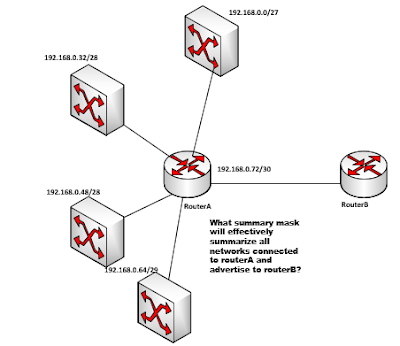In Cisco CCNA, summarization is one of the topics many students wish to skip because they find it difficult to get a grip around it. Most authors of best-selling CCNA books have not done much to help the students by commit less pages to treating this simple but dreaded topic.
Points to note about summarization:
>> Reduces route entries in a router’s routing table
>> Reduces the size of route updates
>> Increase convergence time
>> Can be done with RIP version 2, EIGRP and OSPF
>> Saves bandwidth
In this example, we have the following networks on RouterA that need to be advertised to to routerB:
192.168.0.0/27
192.168.0.32/28
192.168.0.48/28
192.168.0.64/29
192.168.0.72/30
A conventional approach will be to advertise them separately. This will mean five entries in routerB’s routing table. It will work just fine but with summarization, it will work better by reducing the route entries on routerB to just one. Also, knowing that route updates between both routers make use of your bandwidth makes considering the size of the route update a good thing, and summarization is the tool to do that. To better understand summarization, you need an excellent understanding of subnetting.
You may also like: how to subnet class B addresses.
For this example, the change is happening in the fourth octet and the range is from 0 to 75. That said, we need to find the number of bits that can be turned on from the host bits so that the block size of the resultant subnetmask can cover the range we have in this example. One bit on will give us a block size of 128 (this does the job even though it covers beyond the range of 0 to 75 given in this example. This is because two bits on will give us a block size of 64 which is not enough)
Range of the network:
First network: 0 to 31
Second network: 32 to 47
Third network: 48 to 63
Fourth network: 64 to 71
Fifth network: 72 to 75.
One bit on will give /25 which is equal to 255.255.255.128. Block size will be 256-128=128. Our summary address and mask therefore, will be 192.168.0.0/25
Example 2:
Given the following networks, generate a summary mask that summarizes the networks into one:
172.16.0.0/24
172.16.1.0/24
172.16.2.0/24
172.16.3.0/24
Answer:
Change is happening in the third octet and it goes from 0 to 3. That’s is a block size of 4; from 0 to 3 is 4, right? So we look for the number of bits we can turn on in the third octet so that its block size can give us 4. The answer is 6 bits, since 6 bits on is 252 and 256-252 will give us 4. Therefore the summary mask for the networks listed above is /22 which is 255.255.252.0. Answer: 172.16.0.0/22
You may also like: understanding variable length subnetmask, from start to finish.
Exanple 3:
Given
10.32.0.0/16
10.33.0.0/16
10.34.0.0/16
10.35.0.0/16
Generate a summary address and mask.
Answer: The change is happening in the second octet. The range is from 32 to 35, giving us 4. Now, how many bits can we turn on in the second octet that will give us a block size of 4? six bits! Six bits on will give 252. Therefore, 256-252=4. With that, we have /14 (255.252.0.0) as our summary mask. The summary address and mask will then be 10.32.0.0/14. This will capture from 10.32.0.0 all the way to 10.35.255.255.
You may also like: a complete guide on how to configure route summarization on Cisco routers using EIGRP


1 thought on “Cisco CCNA route summarization: how to generate a summary address and mask for efficient route advertisement”